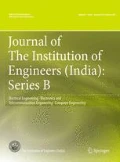Abstract
The availability of daylight on any plane of a building and the passive heat gain due to the corresponding incident solar radiation is correlated by daylight luminous efficacy. The present study was carried out to evaluate daylight efficacy on exterior horizontal plane for Kolkata using Perez Model an established analytical model and Indian measured solar radiation database. The analytical model was selected according to the sky conditions throughout the year. The estimated efficacy models were used to predict horizontal global and diffuse illuminances. The predicted global and diffuse illuminance was validated with the measured illuminance values using standard statistical tools. The estimated Root Mean Square Deviation (RMSD) and Mean Bias Deviation (MBD) between experimental and simulated values of illuminance are +7 % and ±4.5 % respectively. An analytical model of luminous efficacy for Kolkata was also developed from the measured values. From the study, it has been found that diffuse luminous efficacy varies from 114–138 lm/W whereas global luminous efficacy varies from 98–112 lm/W in a year. It is also observed that sky clearness index and diffuse irradiance ratio have significant effect on the variations of luminous efficacy in different seasons.






Similar content being viewed by others
Abbreviations
- ε:
-
Sky clearness
- Δ:
-
Sky brightness
- W:
-
Atmospheric precipitable water content, cm
- Φ:
-
Latitude of place, deg
- δ:
-
Solar declination angle, deg
- ω:
-
Hour angle, deg
- z:
-
Solar zenith angle, deg
- αs :
-
Solar altitude angle, deg
- Kg :
-
Global efficacy, lm/W
- Kd :
-
Diffuse efficacy, lm/W
- Eg :
-
Global illuminance, klux
- Ed :
-
Diffuse illuminance, klux
- Esim,i :
-
Simulated illuminance, klux
- Emeas,i :
-
Measured illuminance, klux
- Emean :
-
Mean value of measured data set, klux
- N:
-
Number of measured data
- Ig :
-
Global irradiance, W/m2
- Ib :
-
Beam irradiance, W/m2
- Id :
-
Diffuse irradiance, W/m2
- In :
-
Normal irradiance, W/m2
- IE :
-
Horizontal extraterrestrial irradiance, W/m2
- n:
-
Julian day of year
- m:
-
Air mass
- h:
-
Height of place above mean sea level, m
- p0 :
-
Atmospheric pressure at sea level, bar
- p:
-
Atmospheric pressure at a height ‘h’, bar
- Td :
-
Hourly surface dew point temperature, °C
- ST:
-
Solar time, hr
References
T. Muneer, Solar irradiance and illuminance models for Japan I: sloped surfaces. Light. Res. Technol. 27(4), 209 (1995)
T. Muneer, Solar irradiance and illuminance models for Japan II: luminous efficacies. Light. Res. Technol. 27(4), 223 (1995)
M. Joshi, R.L. Sawhaney, D. Buddhi, Estimation of luminous efficacy of daylight and exterior illuminance for composite climate of Indore city in Mid Western India. Renew. Energy 32, 1363 (2007)
T. Muneer, R.C. Angus, Daylight illuminance models for United Kingdom: sloped surfaces. Light. Res. Technol. 25(3), 113 (1993)
P.J. Littlefair, The luminous efficacy of daylight: a review. Light. Res. Technol. 17(4), 162 (1985)
P.J. Littlefair, Measurement of the luminous efficacy of daylight. Light. Res. Technol. 20(4), 77 (1988)
S.G. Colaco, C.P. Kurian, V.L. George, A.M. Colaco, Model based evaluation of exterior daylight illuminance distribution. Build. Simul. 2(2), 85 (2009)
A.H. Fakra, H. Boyer, F. Miranville, D. Bigot, A simple evaluation of global and diffuse luminous efficacy for all sky conditions in tropical and humid climate. Renew. Energy 36, 298 (2011)
A. Mani, Rangarajan, Handbook of solar radiation data for India (Applied Publishers, New Delhi, 1980)
R. Perez, P. Ineichen, R. Seals, Modelling daylight availability and irradiance components from direct and global irradiance. Sol. Energy 44(5), 271 (1990)
F. Kasten, Discussion on the relative air mass. Light. Res. Technol. 25, 129 (1993)
J. Wright, R. Perez, J.J. Michalsky, Luminous efficacy of direct irradiance: variation with insolation and moisture conditions. Sol. Energy 42, 387 (1989)
B.Y.H. Liu, R.C. Jordan, The inter-relationship and characteristic distribution of direct, diffuse and total solar radiation. Sol. Energy 4(1), 1 (1960)
Acknowledgments
This paper is a part of Post Graduate Project Thesis of the first author. The authors are thankful to Jadavpur University, Kolkata, India for providing all required facilities to complete this work.
Author information
Authors and Affiliations
Corresponding author
Rights and permissions
About this article
Cite this article
Raul, D., Pal, S. & Roy, B. Application of Perez Daylight Efficacy Model for Kolkata. J. Inst. Eng. India Ser. B 96, 339–348 (2015). https://doi.org/10.1007/s40031-014-0134-8
Received:
Accepted:
Published:
Issue Date:
DOI: https://doi.org/10.1007/s40031-014-0134-8




